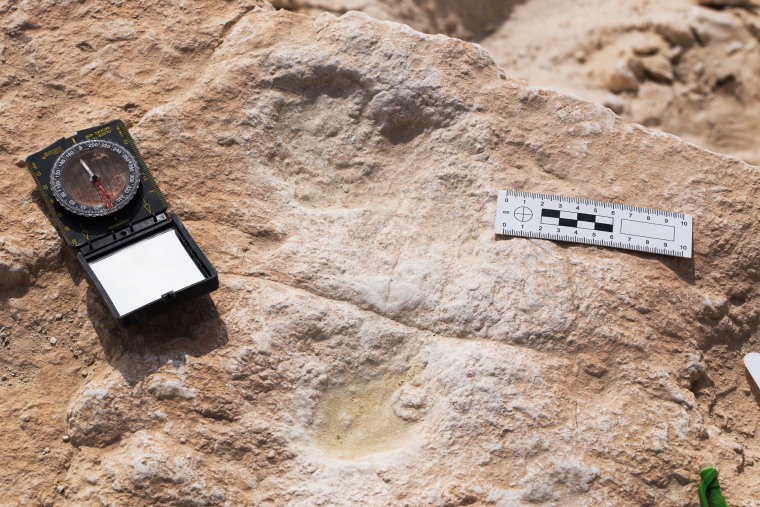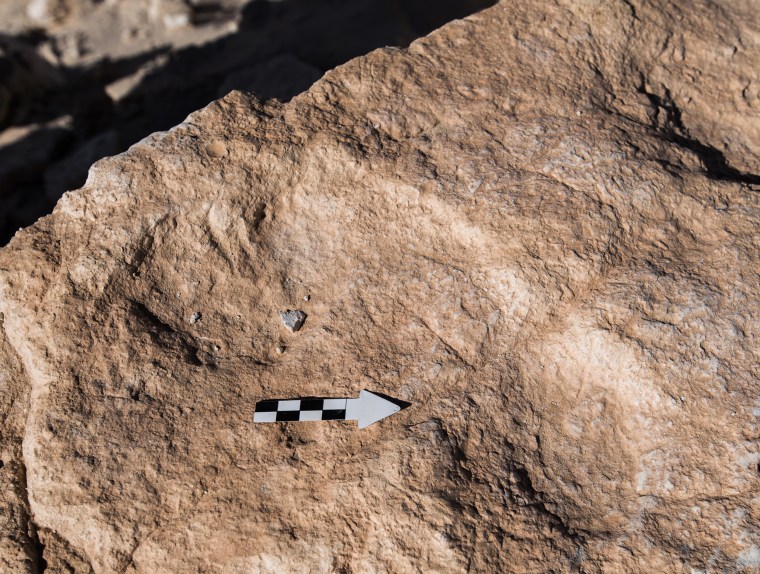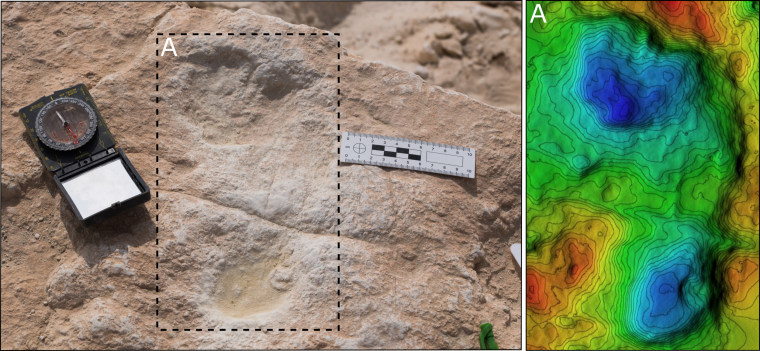The oldest human footprints in the Arabian Peninsula have been discovered on an ancient lakebed deep in Saudi Arabia's Nefud Desert, according to research released Friday.
The fossilized footprints date to between 112,000 and 120,000 years ago and give insights into the routes that early modern humans – Homo sapiens – took out of Africa maybe 5,000 years earlier.
“These footprints suggest there was Homo sapiens dispersal into northern Arabia, probably from Africa, around 125,000 years ago,” said Mathew Stewart, an zooarchaeologist at the Max Planck Institute for Chemical Ecology in Jena, Germany, and the lead author of the study published in the journal Science Advances.
Researchers think the footprints were made on the muddy shoreline of a shallow freshwater lake by primitive hunter-gatherers, who over generations followed herds of wild prey animals from the Sahara into Arabia.
Both regions were then grasslands like the modern African savannah, and the latest discovery is some of the oldest evidence that this was an ancient migration route for early modern humans.
“This is a remarkable set of footprints and a remarkable sight,” said archaeologist and anthropologist Michael Petraglia of the Max Planck Institute for the Science of Human History in Jena. “It’s a first.”

Petraglia has led expeditions into the Nefud for about 15 years to investigate hundreds of ancient lakes identified from satellite photographs that are now dry but which were important watering holes in the distant past.
The hard-packed clay lakebed among the sand dunes and the rocky ridges of the western Nefud – dubbed Alathar, which means “the trace” in Arabic – is the first place his team has found footprints of any kind.
The discovery of at least seven human footprints among the tracks of ancient elephants, camels, buffalo, equids (early ancestors of the horse), and antelopes at the site was astonishing, Petraglia said.
“We never imagined we'd find them," he added.
Analysis of the footprints using a dating technique called optically stimulated luminescence, which measures the light given off by grains of quartz in the clay, indicates the human footprints must have been made by early Homo sapiens.
Although archaeological evidence shows some groups of the ancient human species Homo neanderthalensis – Neanderthals – entered what is now the Middle East up to 50,000 years ago, the footprints were at least 50,000 years too early and too far south to have been made by them, Petraglia said.
Their research also showed the shape of the footprints best matched early Homo sapiens, rather than Neanderthals or people living today, he said.
The researchers think the ancient humans were hunting prey animals, such as elephants and buffaloes, that had gathered at the lake to get water, he said.
They’ve found more than 300 animal tracks and 200 animal fossils at the site, and one group of human footprints – possibly from a hunting party – could show two or three individuals traveling together.
The location of the discovery strengthens the idea that some early Homo sapiens followed animal herds from the Sahara, across the Sinai Peninsula and into Arabia, rather than taking a “coastal route” beside the Mediterranean or a southern land bridge between Africa and Arabia.

Scientists think changes in the ancient climate over millions of years periodically increased the rainfall over both the Sahara and Arabia, making them greener for thousands of years at a time.
“This is a great study,” said geologist Cynthia Liutkus-Pierce of Appalachian State University in Boone, North Carolina, who has investigated ancient human footprints in Tanzania but who was not involved in the latest research.
“They did a pretty good job of supporting the conclusion that, yeah, these are Homo sapiens and they are outside of Africa at 120,000 to 112,000 years ago,” she said.
These are the first ancient human footprints found in Arabia, but they may not be the last.
“We probably missed these kinds of animal and human footprints when we surveyed other ancient lakes elsewhere in Arabia,” said prehistorian Remy Crassard of the National Centre for Scientific Research in Lyon, France, who has studied very ancient stone tools in the region.
“This is a good reason to go back to these sites and to survey more of them, as new footprints could most probably be found,” he said.
